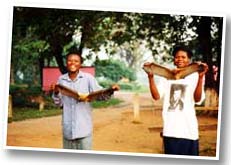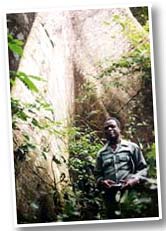

The
Research Project
The Study Area
Background Information
Tools Of The Trade
A Day In The Life Of . . .
A Day In The Life of A Wildlife Biologist . .
September 15, 2001
Today we woke up at 5:15 AM. It was still dark outside and was misting slightly.
We took our flashlights and headed for the trail. We were inside the forest by 5:30 and we began
walking very slowly. By 5:40 it was light enough to see without our flashlights
(though Ghanaians don't generally use flashlights, they are used to walking
in the dark). At 6:13 we heard a sound and stopped to identify it. We heard
it again, a deep boom call of the adult male Lowe's monkey (locally called
monas). Twice more the monkeys called and we waited to see if they would
come closer.
and headed for the trail. We were inside the forest by 5:30 and we began
walking very slowly. By 5:40 it was light enough to see without our flashlights
(though Ghanaians don't generally use flashlights, they are used to walking
in the dark). At 6:13 we heard a sound and stopped to identify it. We heard
it again, a deep boom call of the adult male Lowe's monkey (locally called
monas). Twice more the monkeys called and we waited to see if they would
come closer.
At 6:27 it began to rain so we found a large tree to sit under and stay
dry. It stopped raining by 6:40 (if it rains longer than 20 minutes the
survey is canceled). We waited for a short time to see if the monkeys called
again. We heard nothing more so we kept walking. We had to cross three rivers
and wade through some thick mud before we reached the end of our scout trail
but didn't see any more monkeys. Because we had walked deep into the forest
(rather than in a loop) the only way home was back the way we came.
"We heard another crash to the right of us . . ."
Observations on the return trip in the forest are not counted as data but
are considered observation hours. We started the walk home (again balancing
on sticks rocks and rickety bamboo bridges as we crossed streams). It wasn't
until we were nearly halfway home that we heard the telltale call of a White- crested
hornbill. These hornbills always move with the monkeys so if you hear them
calling you can be sure the monkeys are nearby. They move with all the species
of monkey we have so far encountered in this study. Their call is a long
sorrowful note that sounds a bit eerie but is always a welcome sound. We
stopped and waited for some time in hopes of seeing the monkeys but we did
not see or hear anything. We continued moving up the trail and were just
crossing through a swamp when we heard a loud crash in the trees above us.
We both froze for some indication of what had made the noise. We heard another
crash to the right of us and then I saw a Lowe's monkey jumping from a large
tree into a thicket only 10m in front of me.
crested
hornbill. These hornbills always move with the monkeys so if you hear them
calling you can be sure the monkeys are nearby. They move with all the species
of monkey we have so far encountered in this study. Their call is a long
sorrowful note that sounds a bit eerie but is always a welcome sound. We
stopped and waited for some time in hopes of seeing the monkeys but we did
not see or hear anything. We continued moving up the trail and were just
crossing through a swamp when we heard a loud crash in the trees above us.
We both froze for some indication of what had made the noise. We heard another
crash to the right of us and then I saw a Lowe's monkey jumping from a large
tree into a thicket only 10m in front of me.
Two more Spot-nosed monkeys passed on branches in front of us and we could
hear them making quiet purring sounds. They moved into a thicket just up
the trail from us so we crossed the swamp and moved up a hill toward them.
We could see the branches and vines moving as they came down to the ground
from the trees. Suddenly we heard the distinct call of a male Roloway monkey
and the monkeys were gone, over the ridge and into the next valley. There
is no following monkeys through this thick understory so we didn't try.
We decided this was probably the same group that we heard earlier in the
morning and included around 20 individuals of the three species (Lowe's,
Roloway and Spot-nosed).
After seeing these monkeys we did not hear or see anything else and were
back in camp by 11:00. Time to take a rest before our walk in the afternoon
(if it doesn't rain, the clouds are threatening).
September 18, 2001
"I counted 32 bites on my arms . . ."
Though my last two days in the field have been less than productive monkey-wise,
they have been very exciting. Yesterday we started out late in the afternoon
because we wanted to eat something as we had a very long walk planned (about
20 km). We were going to the National Park, Nini-Suhien (pronounced soo-shee-en)
that is directly above the Ankasa Resource Reserve. The walk was long and
the terrain was steep but nothing beat the difficulty of crossing the Nini
River jumping from rock to rock. At one point the jump was about 3 feet,
I just sat there and laughed. My trusted guide Samuel came to my rescue
and brought me a long stick to help balance across the river. Safely on
the other side we took a short break before setting off to "scout"
the park. We walked for several hours but accomplished nothing more than
getting eaten alive by the ever-present black flies. At one point I counted
32 bites on my arms and legs. My fear of black flies is not of the danger
of river blindness (as maybe it should be) but the unbearable itching that
they cause. Trista, our resident botanist counted over a hundred bites on
her first day here.
I was just about to turn us back when I heard a crash in the trees. Samuel
and I waited for any sign of monkeys. But, before we had much time to think
suddenly it sounded like the sky was caving in-a tree was falling-a BIG
tree-somewhere near us but we couldn't see. We were both poised to run and
I mentioned some unmentionable words and then CRASH, the tree was down.
That was about the scariest moment of my life (apart from the cobra sliding
across my shoe).
Anyway, long story short, I fell in the river on the way home and was lucky
enough to see three groups of Lowe's monkeys and Trista was able to get
some great sound recordings of male loud calls.
"Lightening flashing, thunder shaking, torrential
rains . . ."
Today was more of the same but a little less exciting. That is, less exciting
until the thunderstorm hit. Lightning flashing, thunder shaking, torrential
rains pouring-after nearly six hours in the forest it was a nice break from
the routine but boy was I wet. In fact, I'm still wet-it takes things a
LONG time to dry out in the tropical rainforest.